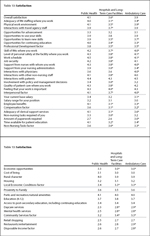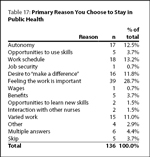Results
Satisfaction
As expected, nurses working in public health were more satisfied with
their workplaces than were nurses working in hospitals and long-term care
 facilities (see Table 13). In fact, 20 (74.1%) of the workplace measures
were significantly different, including four of the seven factors (see
Table 13). All of the statistically significant differences indicated
higher levels of satisfaction among the public health nurses. The most
dramatic differences were seen in “Adequacy of RN staffing where you
work” (4.0 vs. 3.1), “Support from your nursing administration” (3.9
vs. 3.0), “Employee benefits” (4.1 vs. 3.1), “Adequacy of clerical
support services” (4.1 vs. 3.1), and “Time available for patient education”
(4.1 vs. 3.2).
facilities (see Table 13). In fact, 20 (74.1%) of the workplace measures
were significantly different, including four of the seven factors (see
Table 13). All of the statistically significant differences indicated
higher levels of satisfaction among the public health nurses. The most
dramatic differences were seen in “Adequacy of RN staffing where you
work” (4.0 vs. 3.1), “Support from your nursing administration” (3.9
vs. 3.0), “Employee benefits” (4.1 vs. 3.1), “Adequacy of clerical
support services” (4.1 vs. 3.1), and “Time available for patient education”
(4.1 vs. 3.2).
There were few significant differences between public health nurses and their hospital and long-term care nurse counterparts on community satisfaction measures. Only “Economic opportunities,” “Daycare services,” and “Mental health services” were significantly different between the groups.
Public health nurses were somewhat more similar to ambulatory care nurses than hospital and long-term care nurses. However, the groups differed significantly on 15 (55.6%) workplace satisfaction measures. For most of the indicators, public health nurses were more satisfied; however, there were two indicators (“Amount of paperwork required” and “Interactions with physicians”) in which the ambulatory nurses were more satisfied. The most dramatic differences wherein public health nurses were more satisfied were seen in “Opportunities for continuing education” (4.0 vs. 3.3), “Employee benefits” (4.1 vs. 3.3), and “Time available for patient education” (4.1 vs. 3.4).
Like hospitals and long-term care nurses, ambulatory care nurses were similar to public health nurses on measures of community satisfaction. Significant differences were found only in “Economic opportunities,” “Daycare services,” “Mental health services,” and “Restaurants/entertainment.”
Intention to Leave
There were so few public health nurses who indicated an intention to leave that little information can be released without compromising the confidentiality of the respondents. Of the 136 who returned questionnaires, only seven stated that they planned to leave their current job within a year. Of those, almost half (3 or 42.9%) were planning to retire.
Why Would You Leave Nursing?
Question 49 directed respondents to select up to four factors that would
 influence a decision to leave nursing altogether. As seen in Table
14,
the selected answers vary by work setting. Nurses working in public health
were more likely to select “I plan to retire,” “I feel burned out from
nursing,” and “Better advancement opportunities outside nursing” than nurses
in other settings. However, they were less likely to select “Feel overworked,
“I need more autonomy,” and “Better work schedules available outside nursing.”
They were also less likely to leave because of concerns about injury, either
to self or patients.
influence a decision to leave nursing altogether. As seen in Table
14,
the selected answers vary by work setting. Nurses working in public health
were more likely to select “I plan to retire,” “I feel burned out from
nursing,” and “Better advancement opportunities outside nursing” than nurses
in other settings. However, they were less likely to select “Feel overworked,
“I need more autonomy,” and “Better work schedules available outside nursing.”
They were also less likely to leave because of concerns about injury, either
to self or patients.
Longevity
As seen in Table 15, the average length of tenure as a public health
nurse for those who responded to the questionnaire was 11 years. The range
was  0 to 39 years. By region, the state supervisors had the longest tenure
at 18.6 years, followed by the central region at 13.8 years. The southeast
and southwest regions had the shortest average tenures with 9.4 and 10.0
years, respectively.
0 to 39 years. By region, the state supervisors had the longest tenure
at 18.6 years, followed by the central region at 13.8 years. The southeast
and southwest regions had the shortest average tenures with 9.4 and 10.0
years, respectively.
There was no significant relationship between experience as a public health nurse and the satisfaction factors. However, there were three correlations between individual satisfaction indices and public health tenure. Satisfaction scores with RN staffing and with adequacy of clerical staff were both inversely related to years of experience (p < .03 and p < .04, respectively). There was also a positive relationship between public health experience and satisfaction with opportunities to use nursing skills (p < .02).
Funding Source
There were no significant differences in satisfaction factors or individual satisfaction measures between county and state funded nurses. Similarly, there were no differences in satisfaction between position titles.
Starting Work in Public Health Nursing
Question 14 of the questionnaire asked respondents to select the primary reason for choosing to work in public health. Table 16 contains the results. The largest percentage (33.1%) selected “Work schedule.” “Feeling the work is important” was the second most popular choice with 16.9% of the total.
Staying in Public Health Nursing
Similar to Question 14 of the questionnaire, Question 15 asked  respondents
to select the primary reason for staying in public health. The majority
(28.7%) selected “Feeling the work is important” followed by “Work schedule”
with 13.2% (see Table 17).
respondents
to select the primary reason for staying in public health. The majority
(28.7%) selected “Feeling the work is important” followed by “Work schedule”
with 13.2% (see Table 17).
